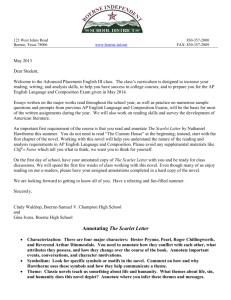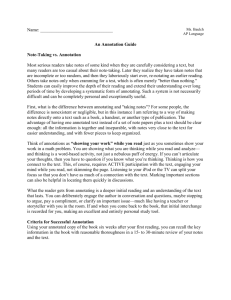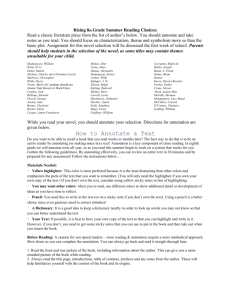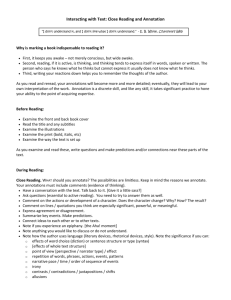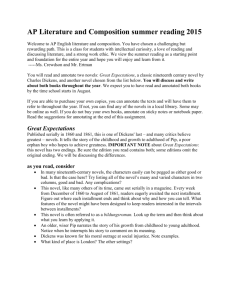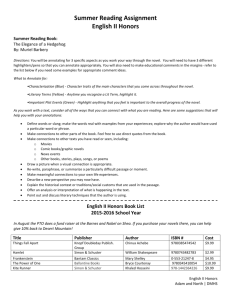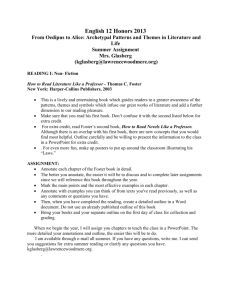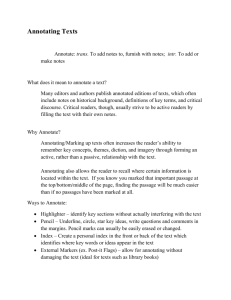AP English Literature and Composition (Senior Level) Summer
advertisement
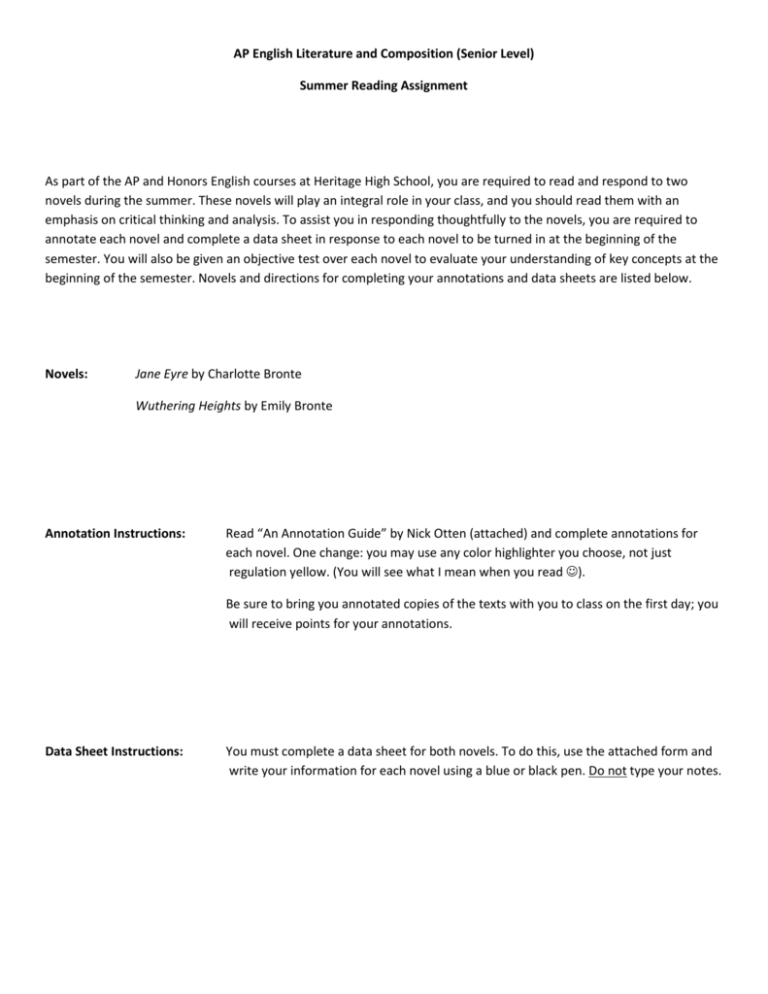
AP English Literature and Composition (Senior Level) Summer Reading Assignment As part of the AP and Honors English courses at Heritage High School, you are required to read and respond to two novels during the summer. These novels will play an integral role in your class, and you should read them with an emphasis on critical thinking and analysis. To assist you in responding thoughtfully to the novels, you are required to annotate each novel and complete a data sheet in response to each novel to be turned in at the beginning of the semester. You will also be given an objective test over each novel to evaluate your understanding of key concepts at the beginning of the semester. Novels and directions for completing your annotations and data sheets are listed below. Novels: Jane Eyre by Charlotte Bronte Wuthering Heights by Emily Bronte Annotation Instructions: Read “An Annotation Guide” by Nick Otten (attached) and complete annotations for each novel. One change: you may use any color highlighter you choose, not just regulation yellow. (You will see what I mean when you read ). Be sure to bring you annotated copies of the texts with you to class on the first day; you will receive points for your annotations. Data Sheet Instructions: You must complete a data sheet for both novels. To do this, use the attached form and write your information for each novel using a blue or black pen. Do not type your notes. An Annotation Guide: How and Why to Annotate a Book By Nick Otten Nick Otten has taught for nearly 40 years—the last 20 at Clayton High School—specializing in American literature, creative writing, and student publication. He has also been adjunct professor at Webster University in St. Louis for 30 years, specializing in teacher training in the Master of Arts in Teaching graduate program. He has published widely on reading, written an editorial column in English Journal, and presented workshops for teachers in the United States, Canada, Mexico, and China. Note-Taking vs. Annotation Most serious readers take notes of some kind when they are carefully considering a text, but many readers are too casual about their note-taking. Later they realize they have taken notes that are incomplete or too random, and then they laboriously start over, re-notating an earlier reading. Others take notes only when cramming for a test, which is often merely "better than nothing." Students can easily improve the depth of their reading and extend their understanding over long periods of time by developing a systematic form of annotating. Such a system is not necessarily difficult and can be completely personal and exceptionally useful. First, what is the difference between annotating and "taking notes"? For some people, the difference is nonexistent or negligible, but in this instance I am referring to a way of making notes directly onto a text such as a book, a handout, or another type of publication. The advantage of having one annotated text instead of a set of note papers plus a text should be clear enough: all the information is together and inseparable, with notes very close to the text for easier understanding, and with fewer pieces to keep organized. Think of annotations as “showing your work” while you read just as you sometimes show your work in a math problem. You are showing what you are thinking while you read and analyze—and thinking is a word-based activity, not just a nebulous puff of energy. If you can’t articulate your thoughts, then you have to question if you know what you’re thinking. Thinking is how you connect to the text. This, of course, requires ACTIVE participation with the text, engaging your mind while you read, not skimming the page. Listening to your iPod or the TV can split your focus so that you don’t have as much of a connection with the text. Marking important sections can also be helpful in locating them quickly in discussions. What the reader gets from annotating is a deeper initial reading and an understanding of the text that lasts. You can deliberately engage the author in conversation and questions, maybe stopping to argue, pay a compliment, or clarify an important issue—much like having a teacher or storyteller with you in the room. If and when you come back to the book, that initial interchange is recorded for you, making an excellent and entirely personal study tool. Below are instructions adapted from a handout that I have used for years with my high school honors students as well as graduate students. Criteria for Successful Annotation Using your annotated copy of the book six weeks after your first reading, you can recall the key information in the book with reasonable thoroughness in a 15- to 30-minute review of your notes and the text. Why Annotate? • • Annotate any text that you must know well, in detail, and from which you might need to produce evidence that supports your knowledge or reading, such as a book on which you will be tested. Don't assume that you must annotate when you read for pleasure; if you're relaxing with a book, well, relax. Still, some people—let's call them "not-abnormal"—actually annotate for pleasure. • Don't annotate other people's property, which is almost always selfish, often destructive, rude, and possibly illegal. For a book that doesn't belong to you, use adhesive notes for your comments, removing them before you return the text. Don't annotate your own book if it has intrinsic value as an art object or a rarity. Consider doing what teachers do: buy an inexpensive copy of the text for class. Tools: Highlighter, Pencil, and Your Own Text 1. Yellow Highlighter A yellow highlighter allows you to mark exactly what you are interested in. Equally important, the yellow line emphasizes without interfering. Before highlighters, I drew lines under important spots in texts, but underlining is laborious and often distracting. Highlighters in blue and pink and fluorescent colors are even more distracting. The idea is to see the important text more clearly, not give your eyes a psychedelic exercise. While you read, highlight whatever seems to be key information. At first, you will probably highlight too little or too much; with experience, you will choose more effectively which material to highlight. 2. Pencil A pencil is better than a pen because you can make changes. Even geniuses make mistakes, temporary comments, and incomplete notes. While you read, use marginalia—marginal notes—to mark key material. Marginalia can include check marks, question marks, stars, arrows, brackets, and written words and phrases. Use the following system: Use the following format: Inside Front Cover: Major character list with small space for character summary and for page references for key scenes or moments of character development, etc. Inside Back Cover: Build a list of themes, allusions, images, motifs, key scenes, plot line, epiphanies, etc. as you read. Add page references and/or notes as well as you read. Make a list of vocabulary words on a back page or the inside back cover, if there’s still room. Possible ideas for lists include the author's special jargon and new, unknown, or otherwise interesting words. Beginning of Each Chapter: Provide a quick summary of what happens in the chapter. Title each chapter or section as soon as you finish it, especially if the text does not provide headings for chapters or sections. Top margins: provide plot notes—a quick few words or phrases that summarize what happens here. Go back after a chapter, scene, or assignment and then mark it carefully. (Useful for quick location of passages in discussion and for writing assignments). Bottom and Side Page Margins: Interpretive notes (see list below), questions, and/or remarks that refer to meaning of the page. Markings or notes to tie in with notes on the inside back cover. Interpretive Notes and Symbols to be used are: • • • • • • • • • • • Underline or highlight key words, phrases, or sentences that are important to understanding the work . Write questions or comments in the margins—your thoughts or “conversation” with the text. Bracket important ideas or passages. Use Vertical lines at the margin: to emphasize a statement already underlined or bracketed Connect ideas with lines or arrows. Use numbers in the margin: to indicate the sequence of points the author makes in developing a single argument. Use a star, asterisk, or other doo-dad at the margin (use a consistent symbol): to be used sparingly, to emphasize the ten or twenty most important statements in the book. Use ??? for sections or ideas you don’t understand. Circle words you don’t know. Define them in the margins. A check mark means “I understand”. Use !!! when you come across something new, interesting, or surprising. • And other literary devices (see below). Some of the things you may want to mark as you notice them are: • Use an S for Symbols: A symbol is a literal thing that also stands for something else, like a flag, or a cross, or fire. Symbols help to discover new layers of meaning. • Use an I for Imagery: Imagery includes words that appeal to one or more of the five senses. Close attention to imagery is important in understanding an author’s message and attitude toward a subject. • Use an F for Figurative Language: Figurative language includes things like similes, metaphors, and personification. Figurative language often reveals deeper layers of meaning. • Use a T for Tone: Tone is the overall mood of a piece of literature. Tone can carry as much meaning to the story as the plot does. • Use a Th – Theme: In literature, a theme is a broad idea in a story, or a message or lesson conveyed by a work. This message is usually about life, society or human nature. Themes explore timeless and universal ideas. Most themes are implied rather than explicitly stated. • Plot elements (setting, mood, conflict, etc.) • Diction (effective or unusual word choice) As you mark, you begin to notice patterns the author has or where he or she deviates from a pattern and much of the work of a critical or analytical reader is noticing these patterns and variations. Notice that annotations are meant to be more than a “scavenger hunt” for literary techniques and rhetorical devices. Along with marking these you should comment on the effectiveness or significance of the device. It’s great if you can detect sibilance in a passage, but that in and of itself is useless unless you can tell that this sibilance demonstrates the mental breakdown of the character for example. It’s amazing if you recognize the hubris of a character, but how does this instance differ from those occurring previously in the novel? 3. Your Text Inside the front cover of your book, keep an orderly, legible list of "key information" with page references. Key information in a novel might include themes; passages that relate to the book's title; characters' names; salient quotes; important scenes, passages, and chapters; and maybe key definitions or vocabulary. Remember that key information will vary according to genre and the reader's purpose, so make your own good plan. A P L I T E R A T U R E Title: Author: D A T A S H E E T Provide significant details about the author (style, philosophies, criticism, etc.): [Give biographical data and an example of the author's style.] Publication Date: Outside source(s): Literary Era: Information about the era (historical, philosophical, etc.): Identify the genre: Plot points (bullet key events): How does this work fit into the genre? The era? Describe the novel’s settings and explain the significance of each: Explain the use & effect of three literary techniques: Cite and quote one example of each: 1. 1. 2. 2. 3. 3. Cite and quote three significant passages: Explain the significance of each passage, or explain how the passage relates to the work as a whole: 1. 1. 2. 2. 3. 3. Identify and explain key metaphors (M), symbols (S), and motifs (F) found in the work: Significant Characters Major characters: Relationship to others: Three Adjectives: Purpose / function in story: 1. 1. 1. 1. 2. 2. 2. 2. Minor characters: Relationship to others: Three Adjectives: Purpose / function in story: 6. 6. 6. 6. 7. 7. 7. 7. Write and explain the THEME(S) of the work: HTCHS version Write at least 3 essay prompts for the novel:
